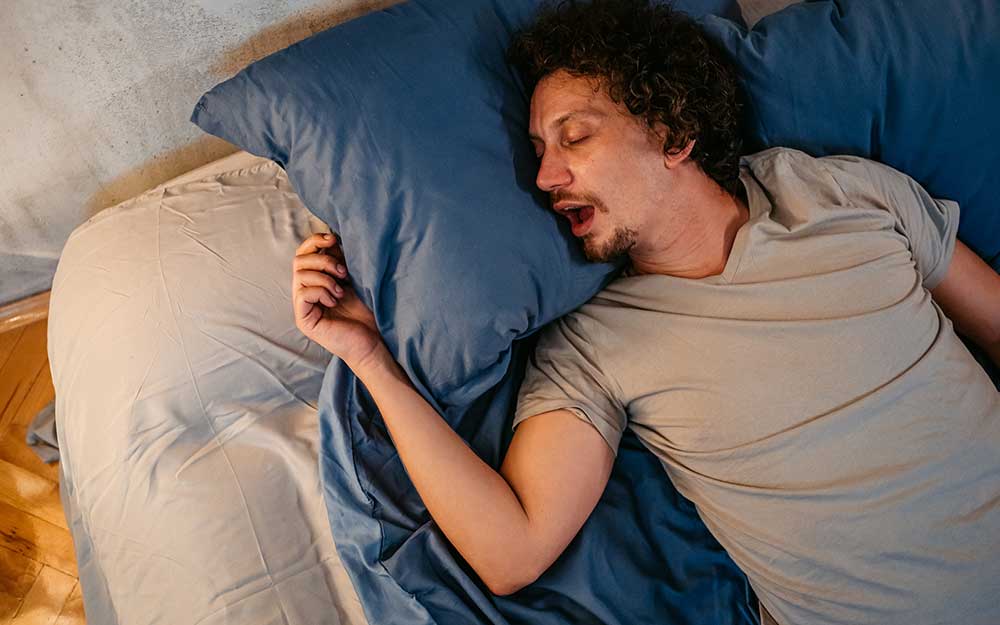Cedars-Sinai Magazine
Sleep Apnea Treatment Unmasked
Nov 06, 2024 Victoria Pelham

The vast majority of people who have sleep apnea do not receive any treatment.
This respiratory disorder, which affects nearly 24 million Americans, disrupts breathing and oxygen as a person sleeps. Airflow restrictions cause people with sleep apnea to snore and choke. (Sometimes these are the only clues they have apnea.) The disturbances can quickly add up, reaching as many as 20 to 30 each hour.
The next day, restlessness leaves behind a hangover of drowsiness, headaches and concentration problems, which can worsen the person’s school and work performance over time. Poorly managed sleep apnea is closely tied to accidents, diabetes, heart disease, hypertension, strokes and even a shorter lifespan.
"We’re starting to understand the long-term health consequences of sleep apnea," said Cedars-Sinai otolaryngologist Kathryn Kreicher, MD, "but patients are mostly unaware."

Kathryn Kreicher, MD
Around 80% of sleep apnea cases are undiagnosed, while the main treatment is inconsistent. Just 30% to 60% of patients prescribed a continuous positive airway pressure (CPAP) mask reliably follow the regimen.
In an effort to improve rates of care, sleep doctors are expanding treatment options. The latest advance is a mask-free surgical implant that stimulates the upper airway. The FDA approved the device in 2023.
"For a really long time, CPAP was all that was out there, and we struggled with answers on why some patients’ airways were still collapsing," said Cedars-Sinai otolaryngologist Ankona Ghosh, MD. "This new procedure will lead to much more effective treatment, because people have options."
Read: How to Get Better Sleep

Ankona Ghosh, MD
A Pacemaker for Sleep
Both anatomical blockages and faulty brain communication to respiratory muscles are responsible for sleep apnea. In obstructive sleep apnea (OSA), mostly physical barriers—including unusually shaped or large tissues inside the nose, throat or mouth—cut off airflow. Tongues are frequently the cause.
A newly approved device works as a sleep pacemaker for patients with OSA. Surgeons implant an electrode on the hypoglossal nerve that oversees the tongue, as well as a respiratory-sensing lead on the chest wall. When a patient turns the device on, the chest sensor detects breathing, or any breathing interruptions, and sends a strong signal up the nerve to the tongue to clear the pathway.
Implantation typically takes about two hours in an outpatient procedure, with two small incisions in the chest and neck, and one week of recovery. Patients are referred to sleep medicine specialists to turn on the device and then adjust their personalized settings over the next six months to a year. If it works, the device just needs battery replacements over the patient’s life.
This new procedure will lead to much more effective treatment, because people have options."
— Dr. Ankona Ghosh
The device is about 80% effective, according to experts, which is roughly the same rate as CPAP machines—and it is “as well, if not better, tolerated.”
Eligibility is based on:
- Moderate to severe OSA, measured by breath stoppages per hour (apnea-hypopnea index). Between 15 to 30 interruptions is moderate, while more than 30 is considered severe.
- Body mass index under 40.
- A drug-induced sleep endoscopy, which uses a camera to evaluate airway structure (including the site and degree of collapse) and determines which therapy could help.
- Documented intolerance of CPAP treatments.
"There are very real reasons a mask doesn’t work for some people," Ghosh said.
Masks can be challenging for patients who are claustrophobic, who can’t fit the mask, or who have recurrent sinus infections, dry mouth, or sensitive skin that reacts poorly to CPAP treatment. Others travel often and find the machine inconvenient. It doesn’t benefit everyone, either.
Treatment Count Grows
Cedars-Sinai pulmonologist Oragun Rojanapairat, MD, recommends all patients with moderate to severe sleep apnea start with CPAP therapy—the gold standard and oldest form of care.
This face mask is worn during sleep and is secured either inside the nostrils, over the nose, or over the nose and mouth. It is connected via a hose to a machine that propels air directly into the windpipe, overriding blockages. It works best when patients stick to at least four hours per night, five nights a week.
Sleep health experts also use mandibular advancement devices, which are oral appliances that open your throat and airways by moving your lower tongue and jaw forward. These mouthguards usually help mild sleep apnea or snoring, Rojanapairat said, but are unproductive in patients who have dentures or temporomandibular joint disorder.
Similarly, positional therapy—which uses special pillows that keep you from flipping onto your back—can prevent your tongue from dropping backward and blocking oxygen.
Weight loss can help you breathe better, too.
If you can’t find relief through less invasive treatments, your sleep doctor can refer you to a surgeon. In addition to device implantation, surgeons can remove the tonsils and uvula or adjust or reposition jaws, depending on the cause of the patient’s apnea.
"Every patient needs to be treated as an individual based on their specific medical conditions, desires and preferences," Kreicher said. "It’s not one size fits all."

Oragun K. Rojanapairat, MD
An Extra Push
Many people who have sleep apnea snore. Other symptoms are subtle, such as waking up frequently to urinate or mood changes. Repeatedly losing oxygen and feeling exhausted is fuel for depression.
On the flip side, sleep treatment can help patients gain control over their physical and mental health, including heart disease.
Specialists emphasize the need for increased sleep apnea education, testing and care. They hope new treatments will be a catalyst.
"The more people understand that there are sleep apnea treatment options that aren’t the big mask, the more they’ll actually get sleep studies and find out if they have it," Ghosh said. "It takes the fear out of going to sleep at night."


